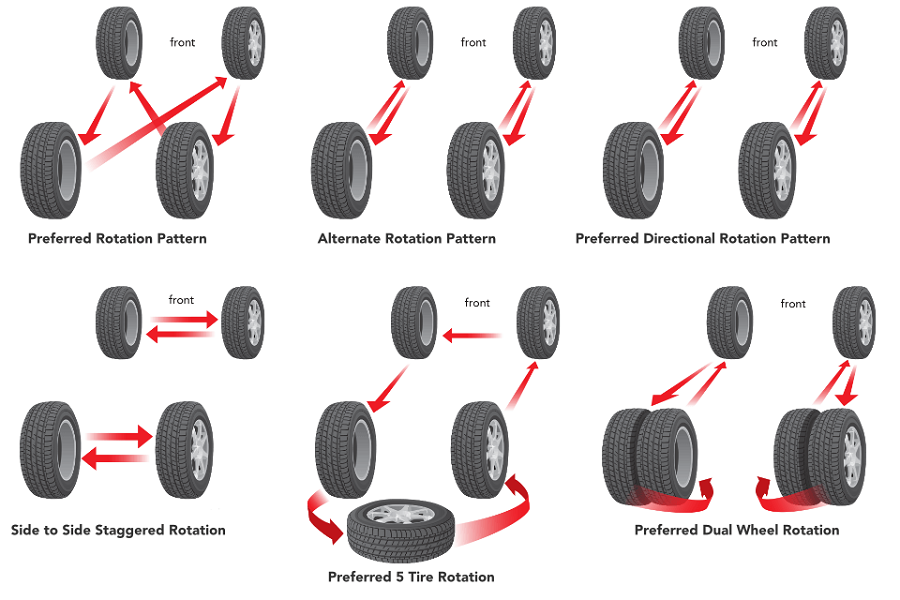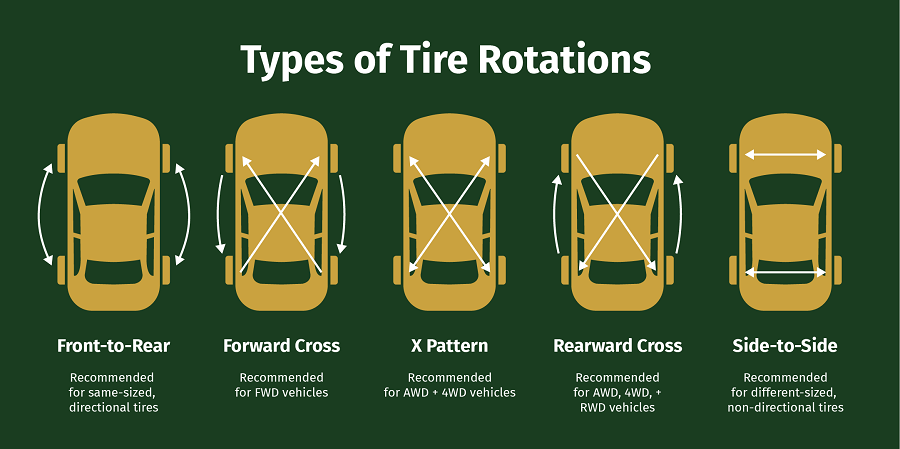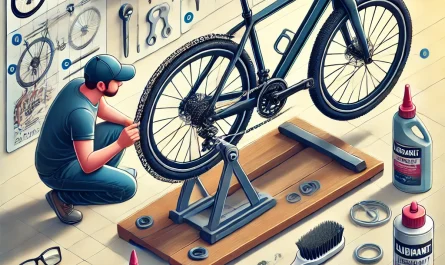Introduction
Tire rotation is a simple yet crucial aspect of vehicle maintenance that often gets overlooked. It involves moving tires from one position to another on your vehicle, ensuring that they wear evenly and last longer. While it may seem like a minor task, tire

rotation plays a significant role in maintaining the overall health and performance of your car.
Why is Tire Rotation Important?
The primary reason for rotating tires is to prevent uneven wear. Tires can experience varying degrees of wear depending on their position on the vehicle. Front tires, for instance, tend to wear faster due to their involvement in steering and braking. By rotating tires, you can help distribute this wear more evenly, extending their lifespan and improving your vehicle’s handling.Additionally, tire rotation can enhance fuel efficiency. When tires are balanced and rotated regularly, they roll more smoothly, reducing rolling resistance. This, in turn, helps your vehicle consume less fuel.By regularly rotating your tires, you can reap numerous benefits that extend beyond simply prolonging their lifespan.
- Even Tire Wear
One of the primary reasons for rotating tires is to prevent uneven wear. Tires can experience varying degrees of wear depending on their position on the vehicle. Front tires, for example, tend to wear faster due to their involvement in steering and braking. By rotating tires, you can help distribute this wear more evenly, extending their overall life. Uneven wear can lead to premature tire replacement, which can be costly and inconvenient.
2. Improved Performance
Tire rotation ensures that all four tires are wearing at a similar rate, contributing to balanced handling and stability. This is particularly important when driving in adverse weather conditions or at high speeds. Uneven tire wear can compromise your vehicle’s ability to respond to sudden maneuvers, potentially leading to accidents.
3. Cost-Effective
While tire rotation may seem like a minor expense, it can actually save you money in the long run. By preventing premature tire replacement, you can avoid unnecessary costs associated with purchasing new tires. Furthermore, well-maintained tires can improve your vehicle’s fuel efficiency, resulting in lower fuel bills.
4. Enhanced Safety
Tire rotation can also reduce the risk of blowouts. When tires wear unevenly, they are more susceptible to developing weak spots that can lead to a blowout. By maintaining even wear, you can help prevent this dangerous situation. Additionally, tire rotation can improve braking efficiency. Tires with consistent tread depth provide better traction, allowing your vehicle to stop more quickly and safely.
Common Misconception that Tire Rotation is Unnecessary
A common misconception is that tire rotation is unnecessary, especially for vehicles with modern tire technology. While advancements in tire design have improved their durability, tire rotation remains an essential practice. Factors such as driving habits, road conditions, and vehicle load can still influence tire wear, even with the latest tire innovations.
When to Rotate Tires
Tire rotation is a vital aspect of vehicle maintenance that can help prolong the life of your tires and ensure optimal performance. While the general recommendation is to rotate your tires every 5,000 to 8,000 miles, there are other factors to consider that may influence the timing of this procedure.
Signs That It’s Time for a Tire Rotation
In addition to adhering to the manufacturer’s recommended mileage, there are several indicators that may signal the need for a tire rotation:
- Uneven Tread Wear: Inspect your tires for uneven wear patterns. If you notice that one side of the tire is wearing out faster than the other, it’s a clear sign that a rotation is necessary.

- Vehicle Pulling to One Side: If your vehicle consistently pulls to one side, it could be due to uneven tire pressure or tire wear. A tire rotation can help address this issue.
- Vibrations or Shaking: If you experience vibrations or shaking while driving, it could be a sign of tire imbalance or uneven wear. Tire rotation can help alleviate these symptoms.
Considerations for Different Driving Conditions and Vehicle Types
The frequency of tire rotations may vary depending on several factors:
- Driving Conditions: If you frequently drive on rough roads, in extreme weather conditions, or carry heavy loads, your tires may wear out faster. In such cases, more frequent rotations may be necessary.
- Vehicle Type: The type of vehicle you drive can also influence tire wear. For example, sports cars or trucks may experience different wear patterns than sedans. Consult your vehicle’s owner’s manual for specific recommendations.
Tire Rotation Patterns
Tire rotation is a fundamental aspect of vehicle maintenance that ensures even wear and extends the lifespan of your tires. Different rotation patterns are recommended based on the type of vehicle and the specific needs of its tires.
Common Tire Rotation Patterns
1. Front-to-Back Pattern: This is the simplest rotation pattern, where tires are moved from the front to the rear and vice versa. While effective for many vehicles, it may not be ideal for those with front-wheel drive (FWD) or rear-wheel drive (RWD) due to differences in tire wear patterns.
2. Cross-Pattern: In this pattern, tires are moved diagonally across the vehicle. This is a popular choice for FWD and RWD vehicles as it helps to even out wear between the front and rear tires.

3. 4-Wheel-Drive Pattern: For four-wheel-drive (AWD) vehicles, the rotation pattern should follow the manufacturer’s recommendations. This often involves rotating tires both front to back and side to side to account for the unique wear characteristics of AWD systems.
Vehicle Type and Rotation Pattern
The choice of rotation pattern is influenced by the vehicle’s drive type:
- FWD Vehicles: The cross-pattern is generally recommended for FWD vehicles as it helps to balance wear between the front and rear tires.
- RWD Vehicles: Similar to FWD vehicles, the cross-pattern is often preferred for RWD vehicles to ensure even wear.
- AWD Vehicles: AWD vehicles require specific rotation patterns that are tailored to their drivetrain configuration. Following the manufacturer’s recommendations is crucial to maintain optimal performance and tire life.
The Importance of Manufacturer Recommendations
It’s essential to adhere to the tire rotation pattern recommended by your vehicle’s manufacturer. These recommendations are based on factors such as the vehicle’s design, suspension setup, and tire specifications. Deviating from the recommended pattern can lead to uneven wear, reduced tire life, and compromised handling.
DIY vs. Professional Tire Rotation
Rotating your tires is a fundamental aspect of vehicle maintenance that can significantly extend their lifespan and improve your vehicle’s overall performance. However, there are two primary options available: doing it yourself (DIY) or entrusting the task to a professional mechanic. Let’s explore the pros and cons of each approach.
DIY Tire Rotation: A Step-by-Step Guide
Tools Needed
- Lug wrench
- Jack
- Wheel chocks
Safety Precautions
- Park on a level surface.
- Engage the parking brake.
- Place wheel chocks under the opposite wheels of the tire you’re about to remove.
Steps
- Loosen the lug nuts: Use the lug wrench to loosen the lug nuts on the tire you want to rotate.
- Raise the vehicle: Position the jack under the vehicle’s jack point near the tire to be rotated. Raise the vehicle until the tire is slightly off the ground.
- Remove the tire: Once the tire is lifted, remove the remaining lug nuts and carefully pull the tire off the hub.
- Rotate the tire: Move the tire to its new position according to your vehicle’s owner’s manual.
- Reinstall the tire: Place the tire back on the hub, tighten the lug nuts by hand, and then use the lug wrench to tighten them securely.
- Lower the vehicle: Lower the vehicle and remove the jack. Tighten the lug nuts again to ensure they are securely fastened.
Benefits of Professional Tire Rotation
While DIY tire rotation can be a rewarding experience, there are several advantages to having a professional mechanic perform the task:
- Precision: Mechanics have the necessary tools and expertise to ensure that your tires are rotated correctly and balanced properly.
- Thorough Inspection: During tire rotation, a professional can inspect your tires for signs of wear, damage, or other issues.
- Additional Services: Many auto repair shops offer additional services such as tire pressure checks, wheel alignments, and brake inspections in conjunction with tire rotations.
Cost Comparison
The cost of DIY tire rotation is primarily the time and effort you invest. However, if you need to purchase any tools or equipment, this can add to the overall cost. Professional tire rotation typically involves a labor charge, which can vary depending on the shop and your location.
Consequences of Neglecting Tire Rotation
Tire rotation is a simple yet crucial aspect of vehicle maintenance that often gets overlooked. While it may seem like a minor task, neglecting tire rotation can have significant consequences for your vehicle’s performance, safety, and your wallet.
Accelerated Tire Wear and Premature Replacement
One of the most immediate consequences of skipping tire rotation is accelerated tire wear. Tires experience varying degrees of wear depending on their position on the vehicle. Front tires, for instance, tend to wear faster due to their involvement in steering and braking. By neglecting tire rotation, you allow this uneven wear to persist, leading to premature tire replacement.
Potential Safety Hazards
Failing to rotate your tires can also pose serious safety hazards. Increased stopping distances can significantly impact your reaction time in emergency situations. Additionally, poor handling can make it more difficult to maintain control of your vehicle, especially in adverse weather conditions.
Impact on Fuel Efficiency
Another consequence of neglecting tire rotation is a decrease in fuel efficiency. When tires are not rotated regularly, they may experience uneven wear, which can lead to increased rolling resistance. This means your engine has to work harder to overcome the resistance, resulting in higher fuel consumption.
Conclusion
Tire rotation is a simple yet often overlooked aspect of vehicle maintenance. By regularly rotating your tires, you can significantly extend their lifespan, improve your vehicle’s performance, and enhance fuel efficiency. Remember to incorporate tire rotation into your regular vehicle maintenance routine.For specific guidelines on tire rotation frequency and procedures, consult your vehicle’s owner’s manual or a qualified mechanic. A small investment of time and effort can go a long way in ensuring the safety and longevity of your vehicle.


